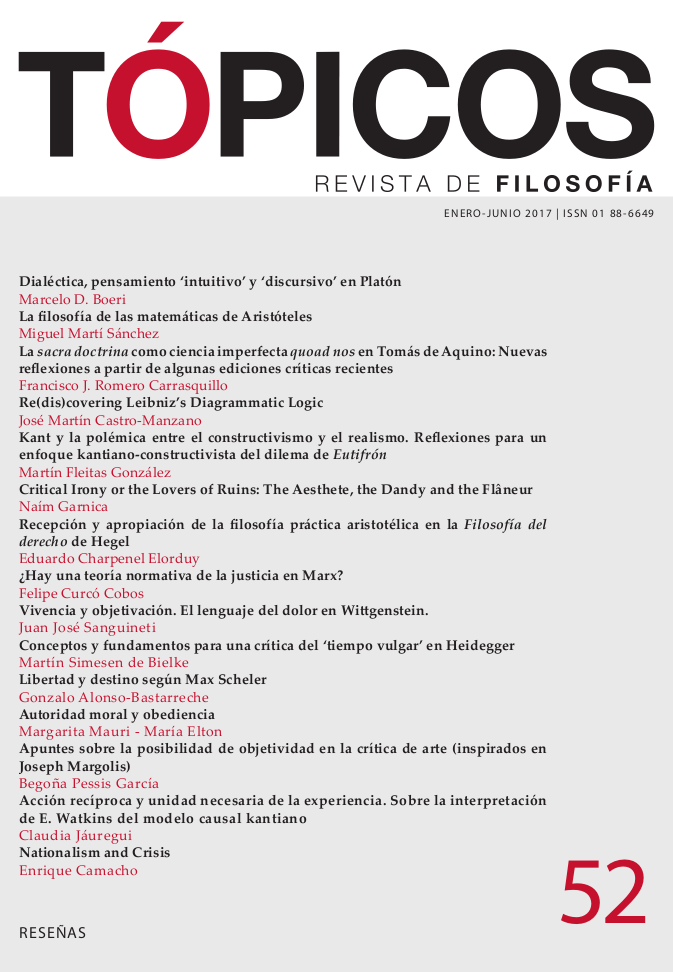Artículos
Critical Irony or the Lovers of Ruins: The Aesthete, the Dandy and the Flâneur
Publiée 2016-12-27
Mots-clés
- irony,
- critical,
- interruption,
- aesthetic,
- romanticism
Comment citer
Garnica, N. (2016). Critical Irony or the Lovers of Ruins: The Aesthete, the Dandy and the Flâneur. Tópicos, Revista De Filosofía, 52, 151-172. https://doi.org/10.21555/top.v0i52.780
Résumé
This essay examines the critical character of Friedrich Schlegel’s Romantic irony, following its considerations and ap- propriations by Walter Benjamin, Harold Bloom and Paul de Man. Likewise, it shows a parallelism of this critical a itude of irony with three Romantic literary gures: the aesthete, the dan- dy and the âneur. These gures, joined by a prophetic faith in art, make of irony a profession which moves between creation and destruction. Appropriation in the poststructuralist context allows us to perceive irony in such a radical incomprehension, developing an aesthetic pa ern that operates between creation and annihilation.
Références
- Agamben, G. (2011). Nudities. California: University of Stanford Press.
- ____(1993). Stanzas. Word and Phantasm in Western Culture. Minneapolis and London: Universidad of Minnesota Press.
- Baudelaire, Ch. (1922). Les Fleurs du Mal. J. Paris: Crepet Ed.
- Behler E. (1990). Irony and Discourse of Modernity. United States of America: University of Washington Press.
- Beiser, F. (2003). The Romantic Imperative: The Concept of Early German Romanticism. Cambridge, MA: Harvard University Press.
- Benjamin, W. (1996), The Concept of Criticism in German Romanticism. In Selected Writings: Volume 1, 1913–1926. Bullock, M. and M. W. Jennings. (ed.) (116-200). Cambridge, Massachuse s, London, England: The Belknap Press of Harvard University Press.
- Blanchot M. (1993). The Infinite Conversation. Minneapolis and London: University of Minnesota Press.
- Bloom, H. et al (1979). Deconstruction and Criticism. New York: Seabury Press.
- Bohrer, H.K. (1989). Die Kritik der Romantik. Der Verdacht der Philosophie gegen die literarische Moderne. Frankfurt am Main: Suhrkamp Verlag.
- Bowie, A. (2003). Aesthetics and Subjectivity. Manchester: Manchester University Press.
- ____(1997). From Romanticism to Critical Theory: The Philosophy of German Literary Theory. London and New York: Routledge.
- Buck-Morss, S. (1995). Dialéctica de la mirada. Walter Benjamin y el proyecto de los pasajes. Madrid: Visor.
- Cacciari, M. (2000). El dios que baila. [The god who dances]. Buenos Aires: Paidós.
- Frank, M. (1984). Was ist Neoestructuralism? Francfort: Suhrkamp.
- Frank, M. (2004). The Philosophical Foundations of Early German Romanticism. Millán Zaibert, E. (trans.) New York: State University of New York Press.
- Gasché, R. (1996). The Sober Absolute: On Walter Benjamin and the Early Romantics. In Ferris, D., Walter Benjamin. Theoretical Questions. (50-74). Stanford: Stanford University Press.
- Givone, S. (2009). Historia de la Nada [History of Nothingness]. Buenos Aires: Edit. Adriana Hidalgo. [Spanish version].
- Hanssen, B. and Benjamin, A. (2002). Walter Benjamin and Romanticism. Nueva York: Continuum.
- Hefferman Jimenez, J. (2007). Prólogo. Introducción. Paul de Man: el camino de la desesperación. In La retórica del romanticismo. (5-75). Madrid: Akal. [Spanish version].
- Hiddleston, J.A. (2005). Art and its representation. In Lloyd, R. (2005) Cambridge Companion to Baudelaire. (130-144). UK.: Cambridge University Press.
- Kierkegaard, S. (1989). The Concept of Irony. Hong and Hong (trans.) Princeton: Princeton University Press.
- Kneller, J. (2003). Introduction. In Kneller, J. (ed.) Novalis: Fichte Studies (ix–xxxiv). Cambridge: Cambridge University Press.
- Lloyd, R. (2005). Cambridge Companion to Baudelaire. UK: Cambridge University Press.
- Man de, P. (1996). Aesthetic Ideology. Andrzej Warminski (ed). Minneapolis: University of Minnesota Press.
- ____(1984). The Rhetoric of Romanticism. New York: Columbia University Press.
- ____(1979). Allegories of Reading: Figural Language in Rousseau, Nietzsche, Rilke, and Proust. New Haven and London: Yale University Press.
- Menke, Chr. (2008). La actualidad de la tragedia. Madrid: La Balsa de la Medusa.
- ____(2009). Tragic Play. Irony and theater from sophocles to beckett. Phillips, J. (trans.) New York: Columbia University Press.
- ____(2011). Estética y negatividad. [Aesthetics and Negativity]. Storandt Diller, P. (trans.) Gustavo Leyva (ed.) México: FCE.
- Rhodes, S. A. (1928). Baudelaire’s Philosophy of Dandyism. In The Sewanee Review, Vol. 36, No. 4, 387-404.
- Sánchez Meca, D. (2013). Modernidad y Romanticismo. Madrid: Tecnos.
- Schlegel F. (1971). Lucinde and the Fragments. Firchow, P. (trans.) London: University of Minnesota Press Minneapolis.
- ____(1991). Philosophical Fragments. Firchow, P. (trans.) London: University of Minnesota Press Minneapolis.
- Schmitt, C. (1986). Political Romanticism. Oakes, G. (trans.) Cambridge, MA: MIT Press.
- Wright, B. (2005). Baudelaire’s poetic journey in Les Fleurs du Mal. In Lloyd, R. (ed.) Cambridge Companion to Baudelaire. (31-50). UK: Cambridge University Press.






